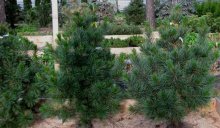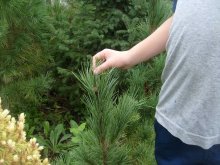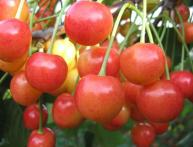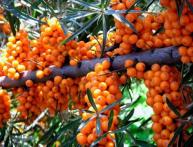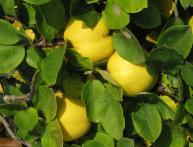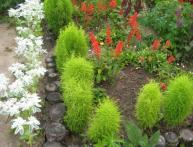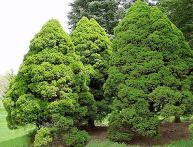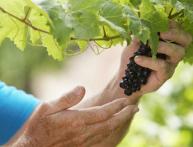European cedar pine: description of a coniferous tree
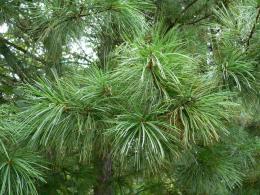
Cedars are very valuable not only for their fruits, but also for their needles and wood. Cedar pines grow in dark coniferous forests and are the main forest-forming and nut-bearing species. There is a wide variety of evergreens coniferous trees, but one of the common ones is the European pine.
Content:
Characteristics of the variety
European pine or European cedar belongs to the coniferous species of the Pinaceae family. The root system is powerful and widely spread. The tree grows slowly, per year the growth is about 15-25 cm in length and 10 cm in width. The pine crown is wide, ovoid, 4-8 m in diameter. Young pines have a smooth, gray-green bark and resinous bubbles.
Mature trees have rough bark with scales. The length of the needles is 5-9 cm, and their thickness is 0.8-1.2 mm. The structure of the needles is dense green with a bluish tint and collected in small bunches. The needles last for 3-5 years. Flowering occurs in late spring and early summer. The cones are ovoid, dark brown, 5-8 cm long and located on small petioles.
The purple-green color of the buds indicates immaturity. They ripen in September the next year after pollination. The cones contain seeds, the size of which is 8-12 mm.
Male cones are characterized by yellow or red needles.They reach 10 mm in length and 5 mm in width. Female cones have an oblong ovoid shape, up to 1 cm long. When they fall off, the cones do not open
Based on morphological similarity, this conifer breed very close to Siberian pine. This ornamental plant is frost-resistant and durable. Cedar wood is widely used for making decorative crafts due to its beautiful pattern. European pine is used in landscape design.
Growing conditions
European pine can be grown in both dry and moist soils. This is a light-loving and wind-tolerant plant, but can grow in the shade. It is better to grow on sandy or sandy loam soils. When planting in sandy soil, add clay.
For good growth and development of an ornamental plant, a soil mixture should be prepared. You will need turf and sand in a 2:1 ratio. If necessary, you can add about 200-300 g of lime per hole. If the soil is heavy, you should add about 20 cm of sand or gravel. Pine can only be propagated by seeds.
Planting and care
It is better to purchase seedlings for planting in a pot. If it is impossible to find such ones, then choose ones with large clods of earth. The seedling must be no older than 3 years. Depending on the varieties the size of cedar pine can be 30 cm and reach 3 m.
First you need to dig up the prepared area. The depth of the hole should be 0.8-1 m. The distance between seedlings should be about 4-6 meters. Before planting seedlings, their roots must be dipped in a clay solution. Drive pegs around the perimeter of the hole. They will serve as support for the tree. When planting, you should add nitroammophoska.
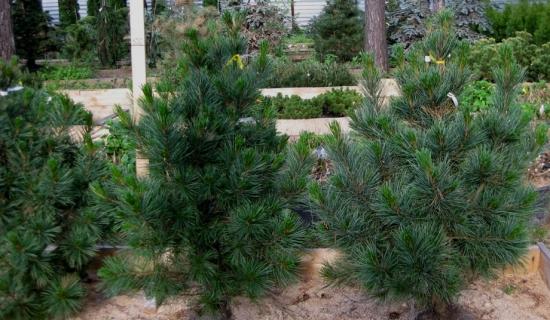
Next, place the seedling in the hole and tie it to pegs.Then cover the hole with earth. This type of pine does not require special care. After planting, feeding the seedling will not be superfluous. Nitroammophoska or humus is used as fertilizer. About 30-40 g of fertilizer will be needed per square meter.
In the spring, after awakening, it needs abundant watering and frequent spraying. For good growth of an ornamental plant, optimal humidity should be maintained. The young tree should be constantly sprayed.
An adult plant does not need watering. Fallen pine needles create a thick litter that retains moisture well. Periodically it is necessary to loosen this layer. To slow down the growth of the tree, annual growths should be broken off. This will allow you to form a thick and lush crown. In winter, young plants should be protected from frost. To do this, the tree is covered with various materials.
Video review of coniferous plants, incl. European cedar pine:
Application of cedar pine
European cedar pine is famous for its valuable wood, from which various crafts, furniture, etc. are made. Items made from European cedar are not subject to rotting and are very durable. Utensils are made from wood. It is believed that milk in it does not sour for a long time and has a pleasant taste.
Needles are actively used in medicine. All components of cedar can be used for medicinal purposes: needles, cones, bark, resin, nut shells. Nut shells are very valuable. It helps with mastopathy, osteochondrosis, arthritis and radiculitis. Dried pine needles can be used for medicinal baths.
Cedar oil is sold in any pharmacy. It is used for varicose veins.The oil is rubbed in with light circular movements in the morning and evening. A decoction based on pine needles helps get rid of scurvy and has a diaphoretic effect. To prepare the decoction, chop the pine needles.
Next, pour the raw material into the glass to the top and add a liter of water. Place the container on low heat and boil for 20 minutes. Then leave to infuse for half an hour. After time, strain and take half a glass. If necessary, you can add sugar or citric acid to add flavor. For the treatment of pulmonary and renal diseases You should take 10 g of cedar buds, chop and leave for 3 hours.
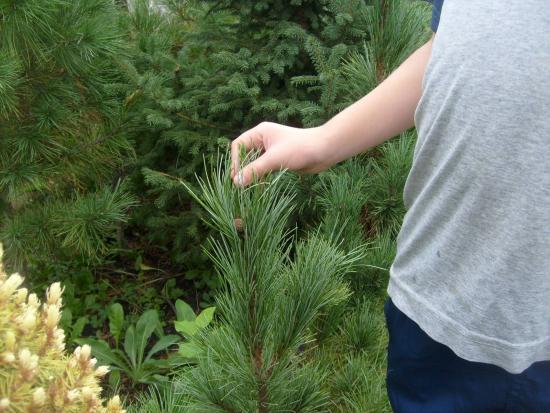
Take a tablespoon daily at intervals of 2-3 hours. An infusion based on nut shells is used for deafness, liver and kidney diseases, as well as nervous pathologies. The remedy helps get rid of stomach diseases and hemorrhoids. In addition, this breed has bactericidal properties. For cuts, wounds and burns, it is useful to lubricate the affected areas with resin.

